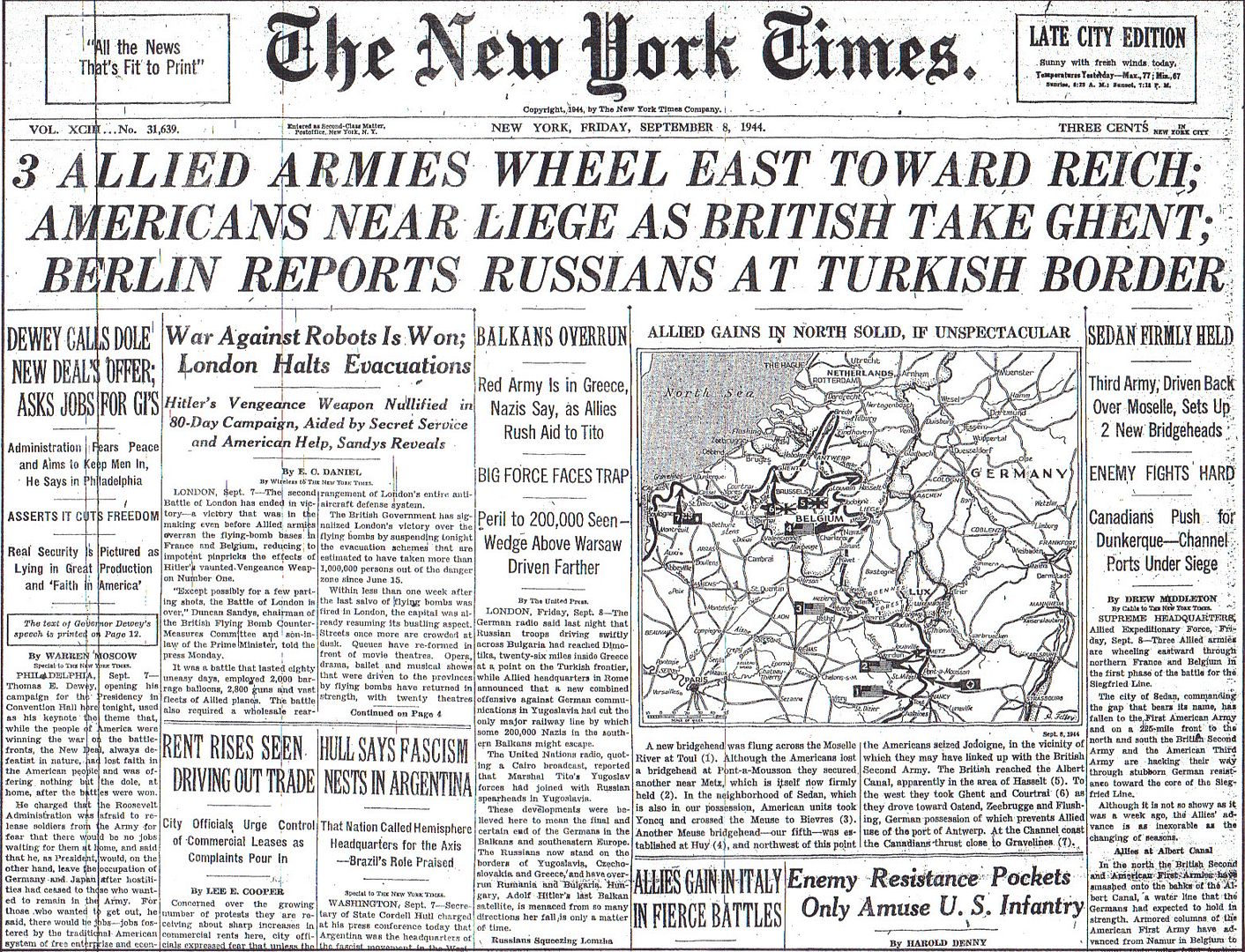
Posted on 09/08/2014 4:26:29 AM PDT by Homer_J_Simpson

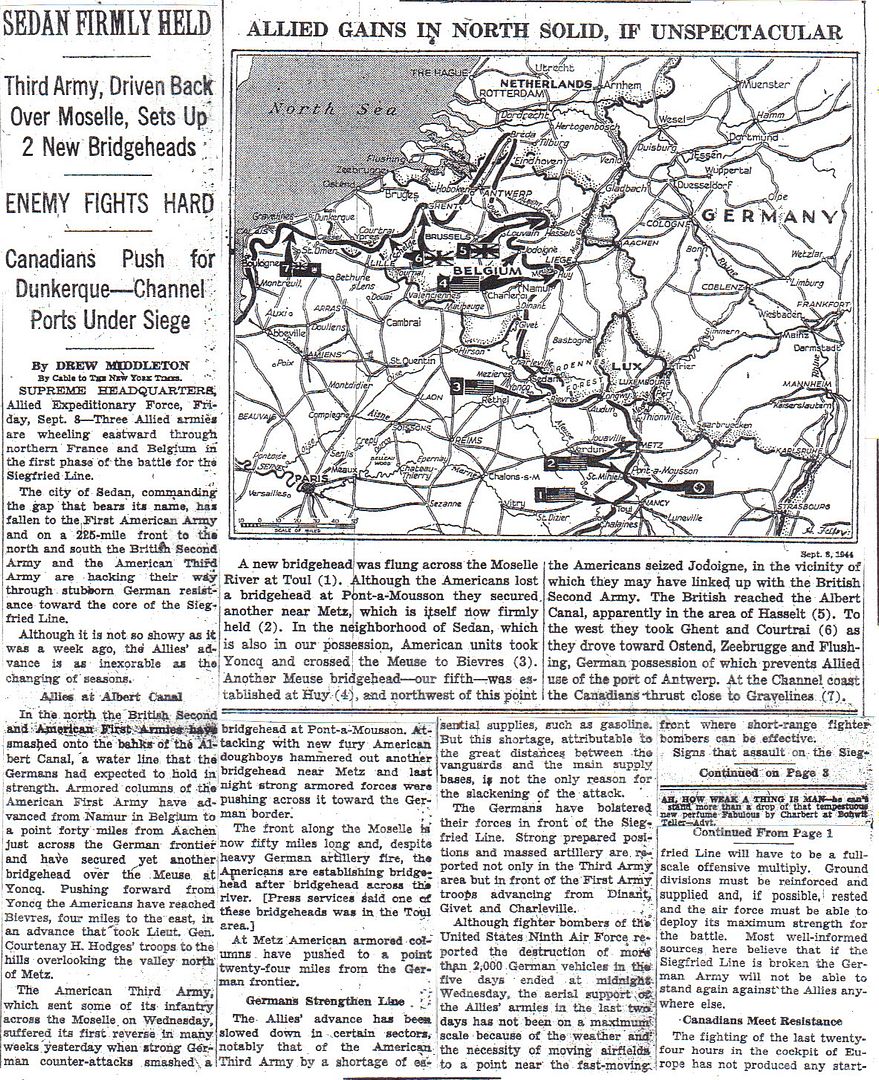
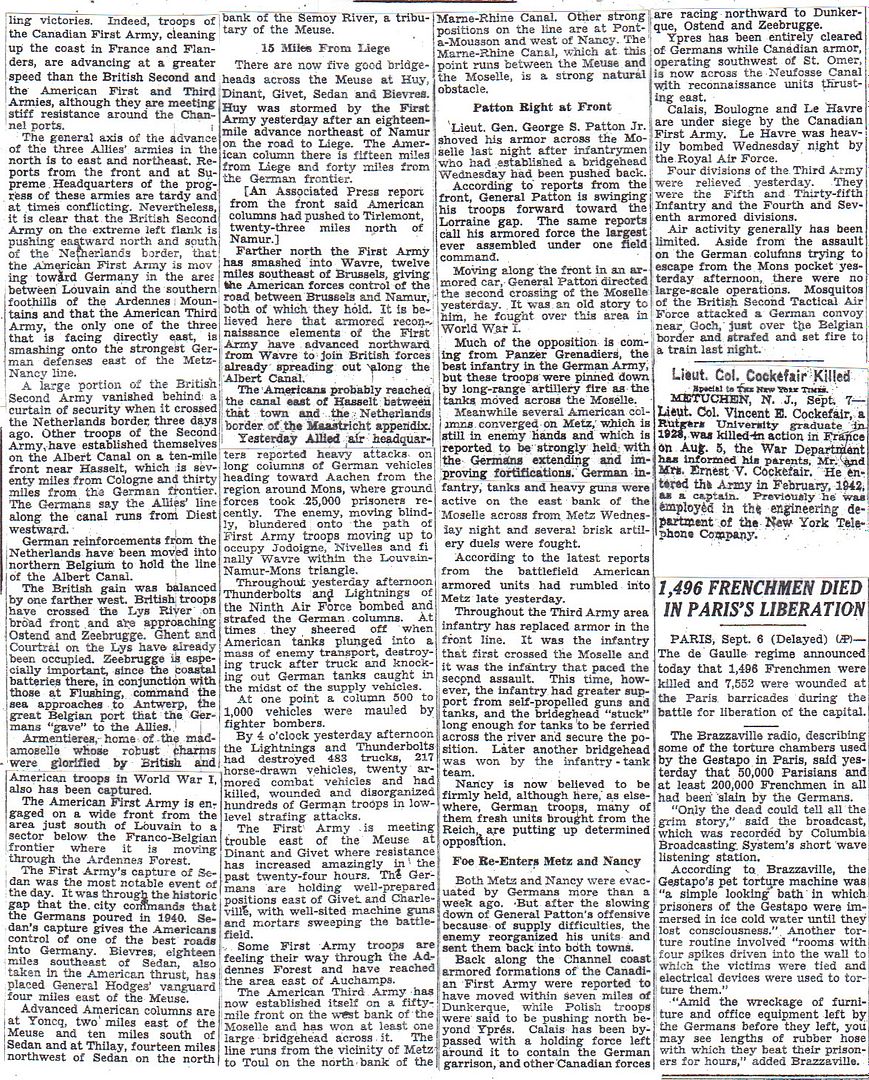
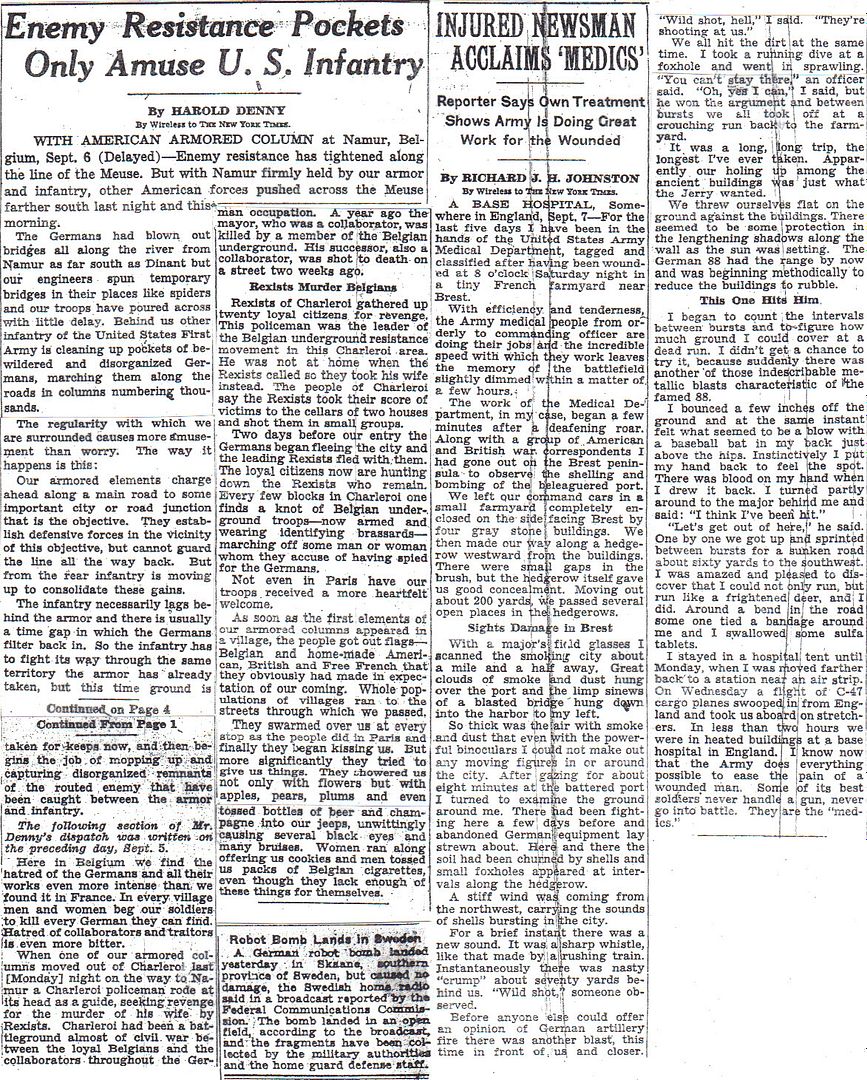


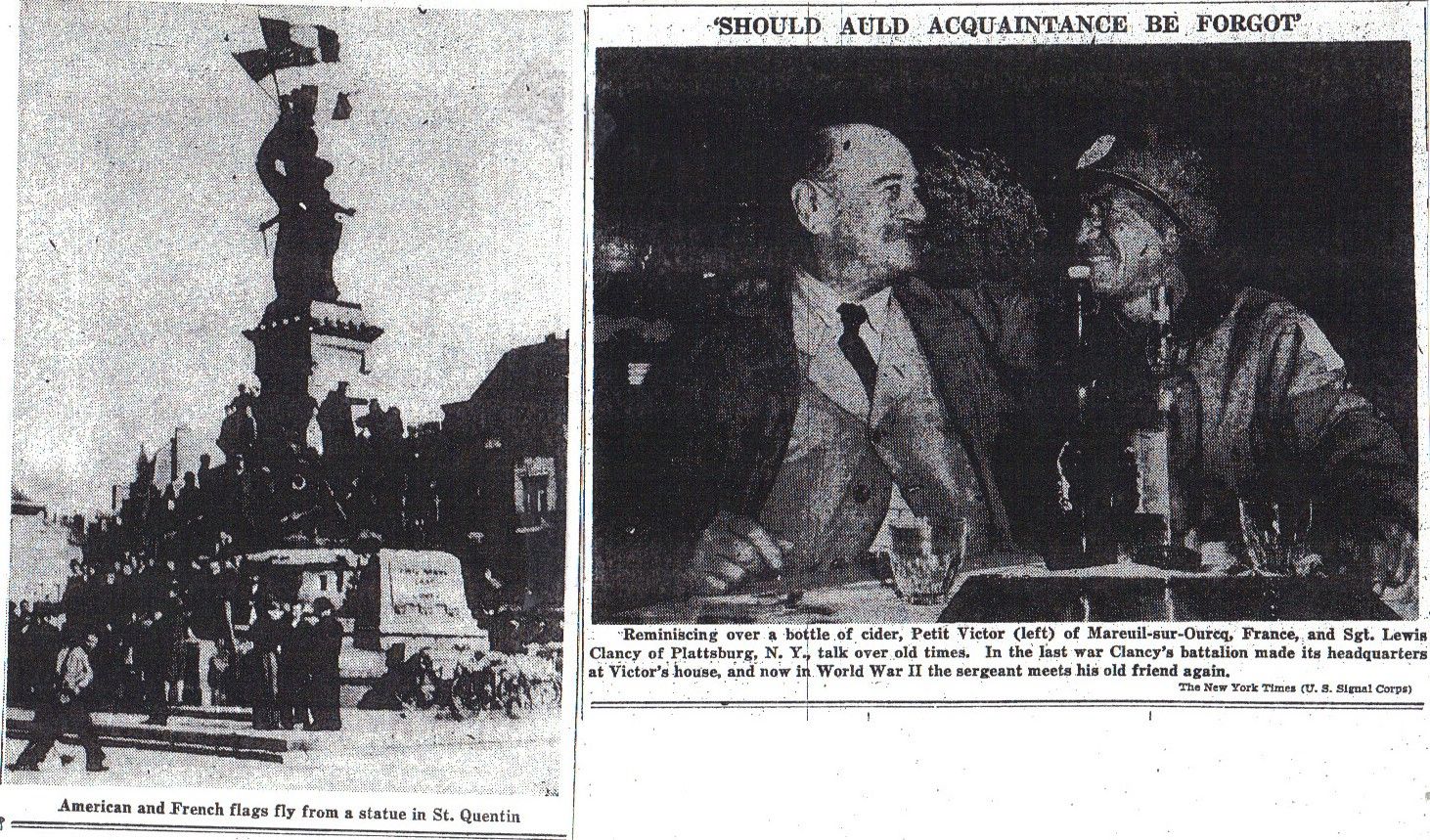
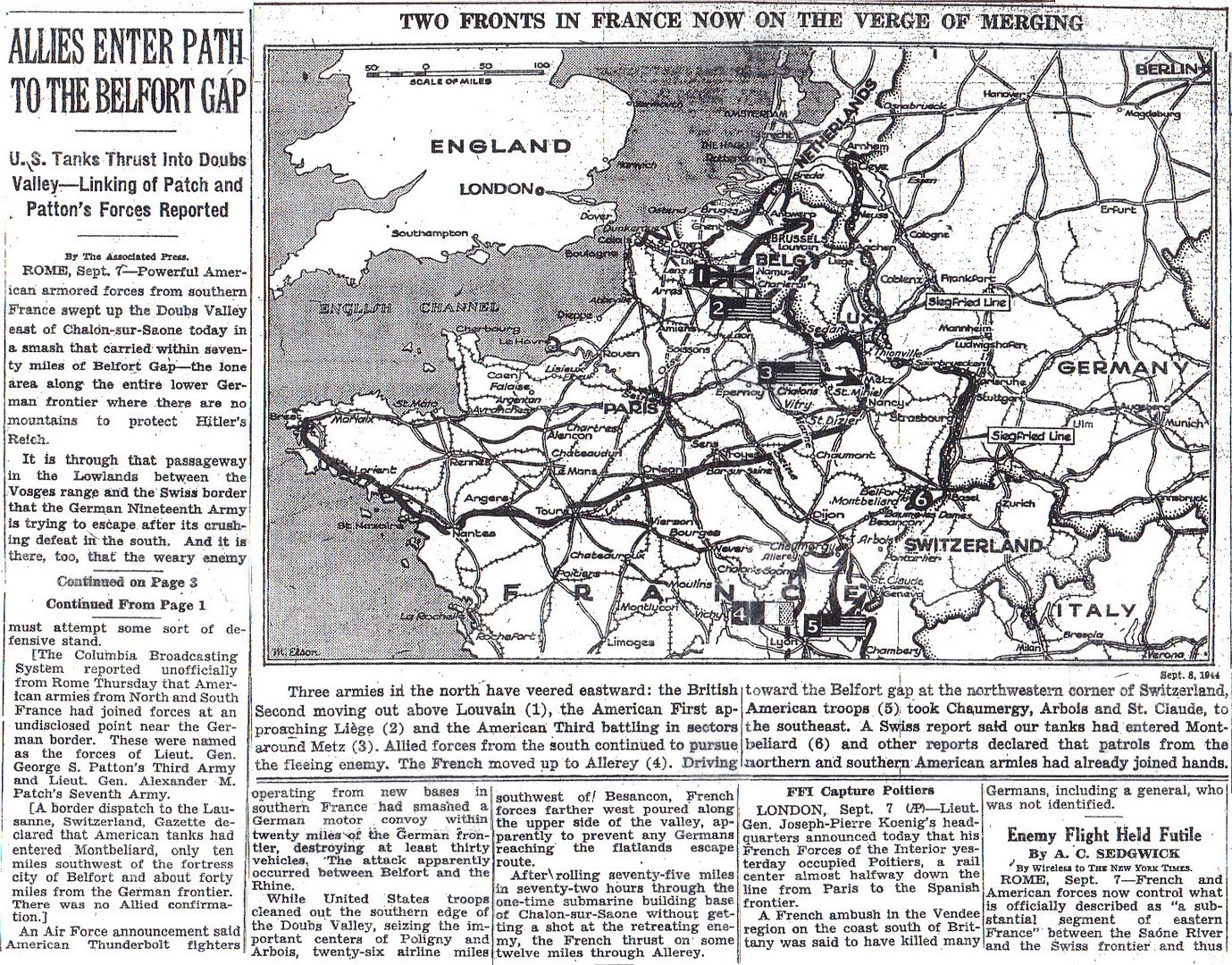
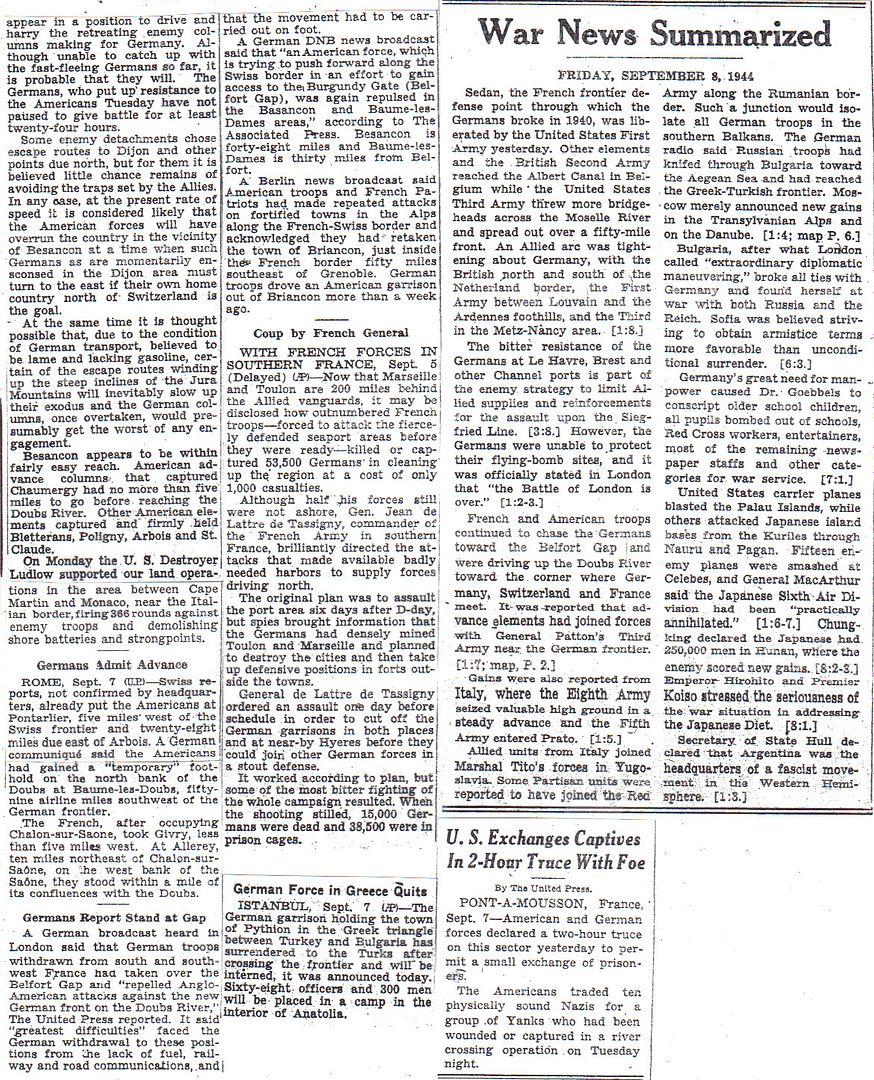
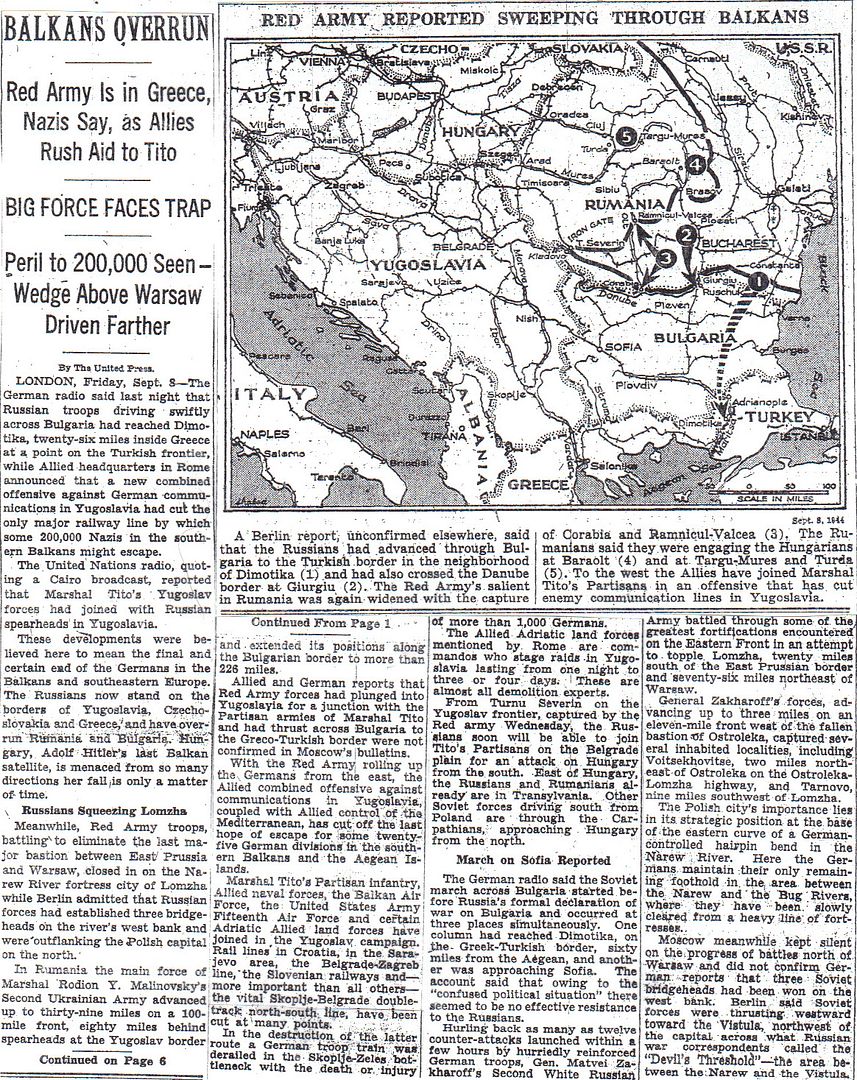
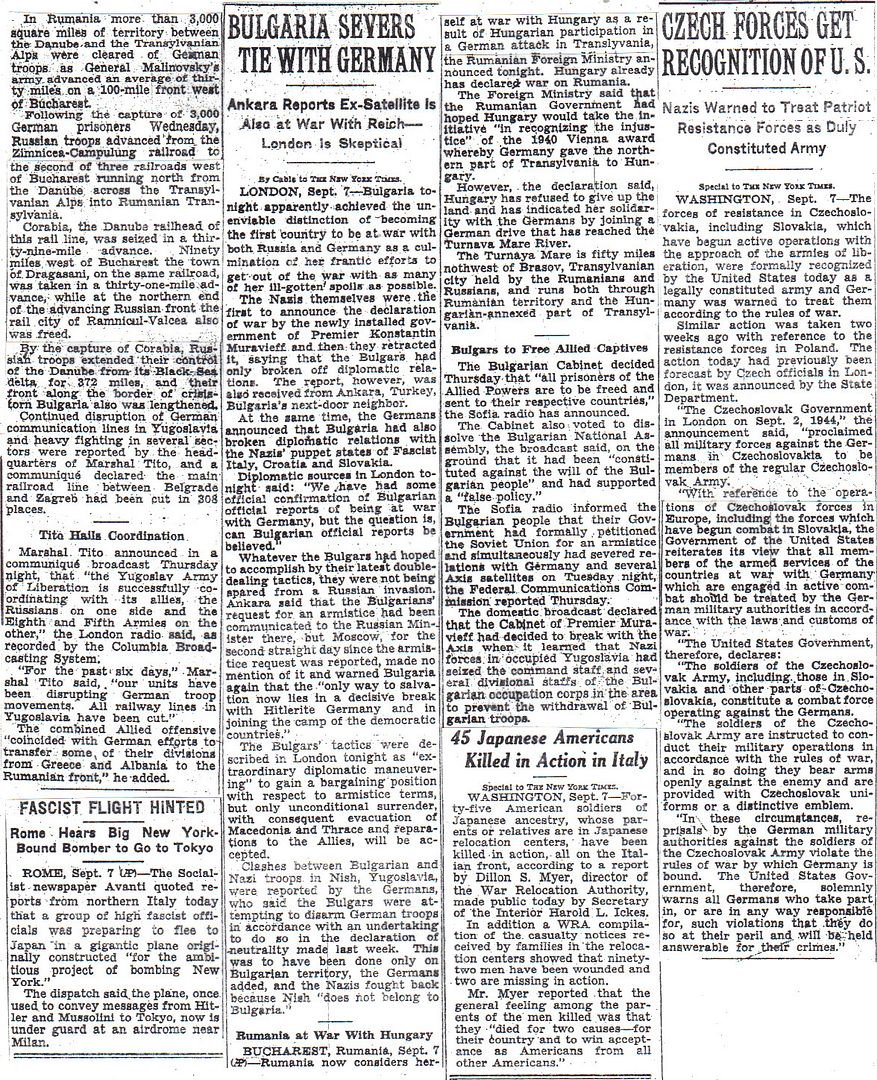
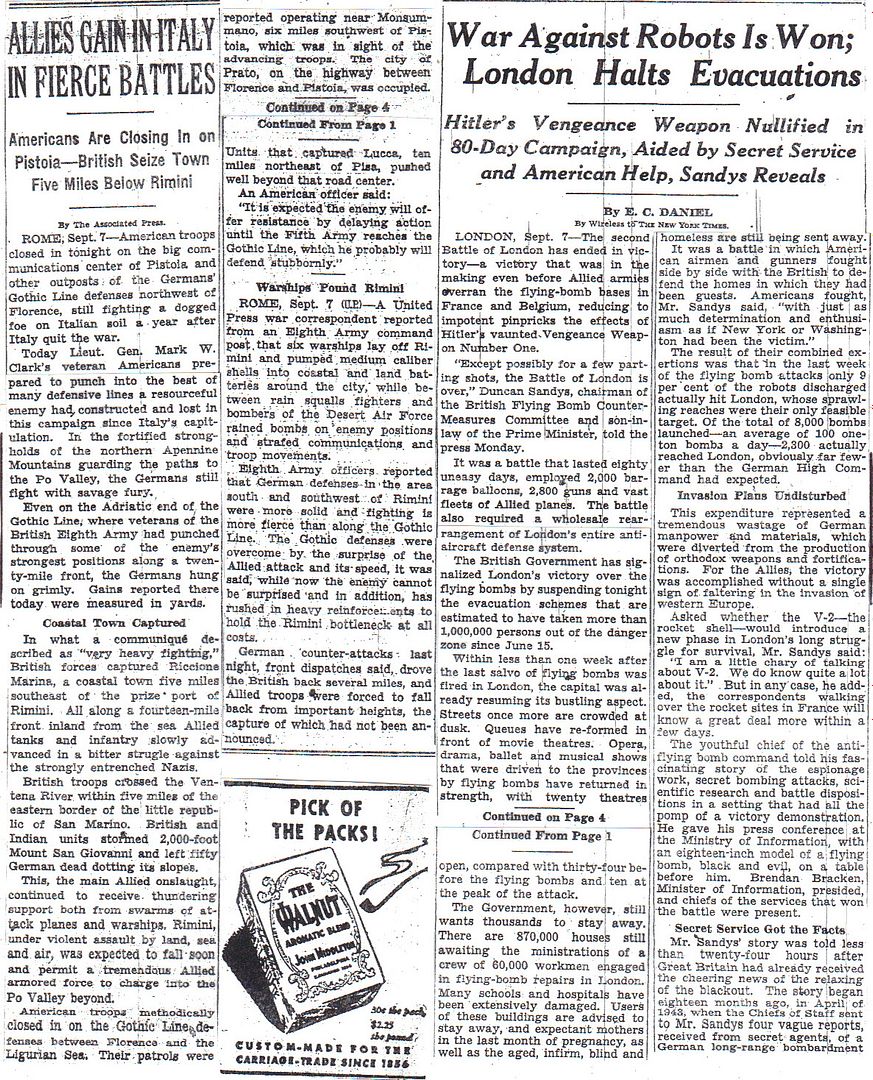
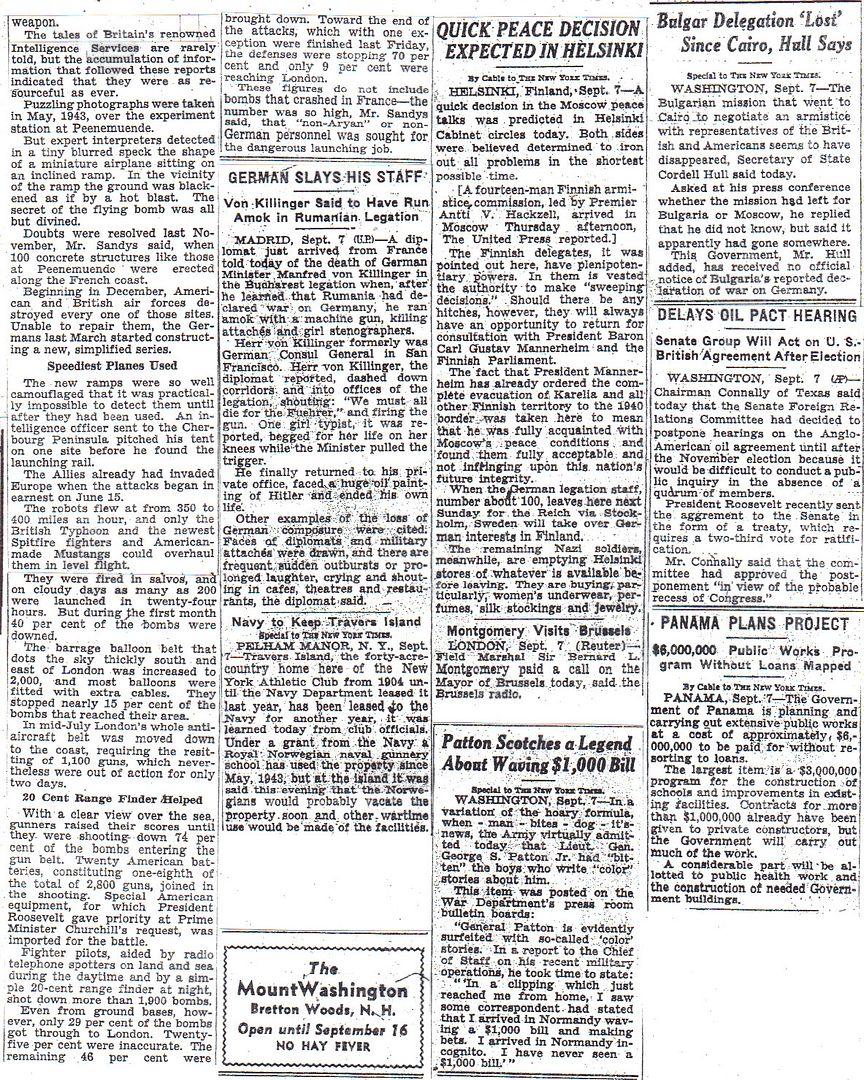
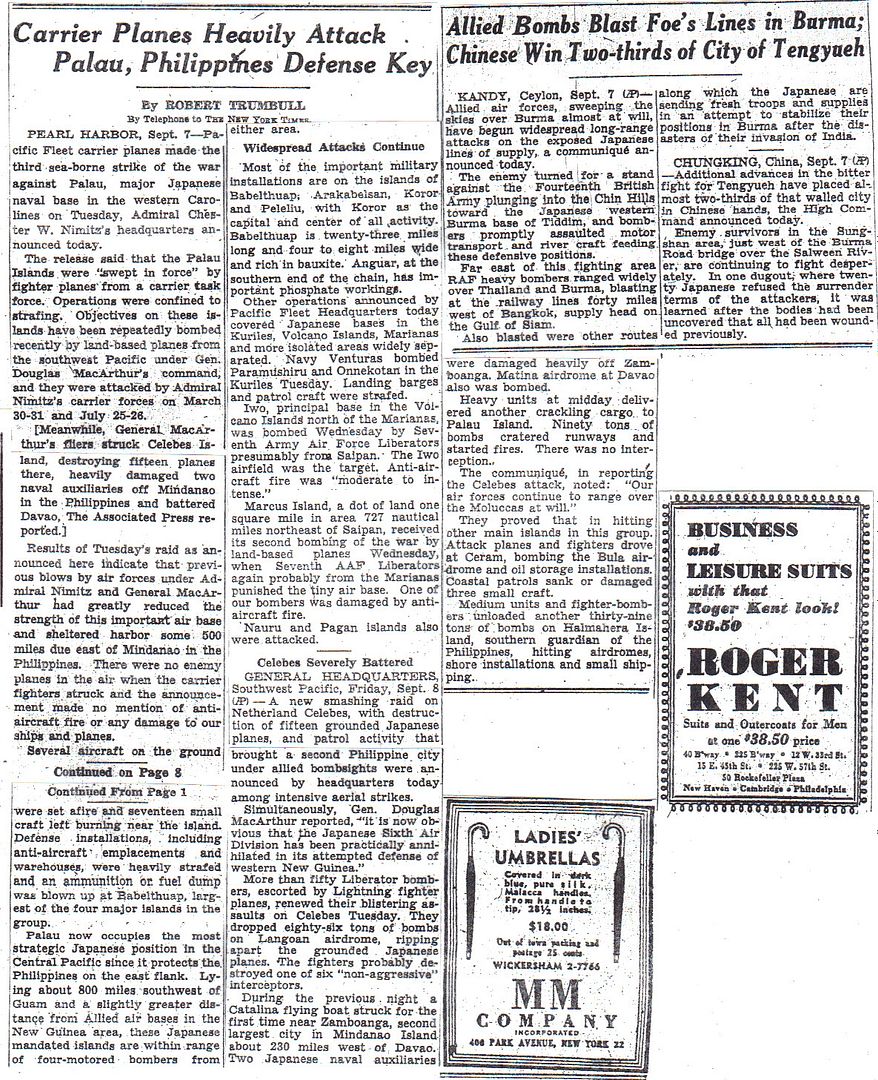
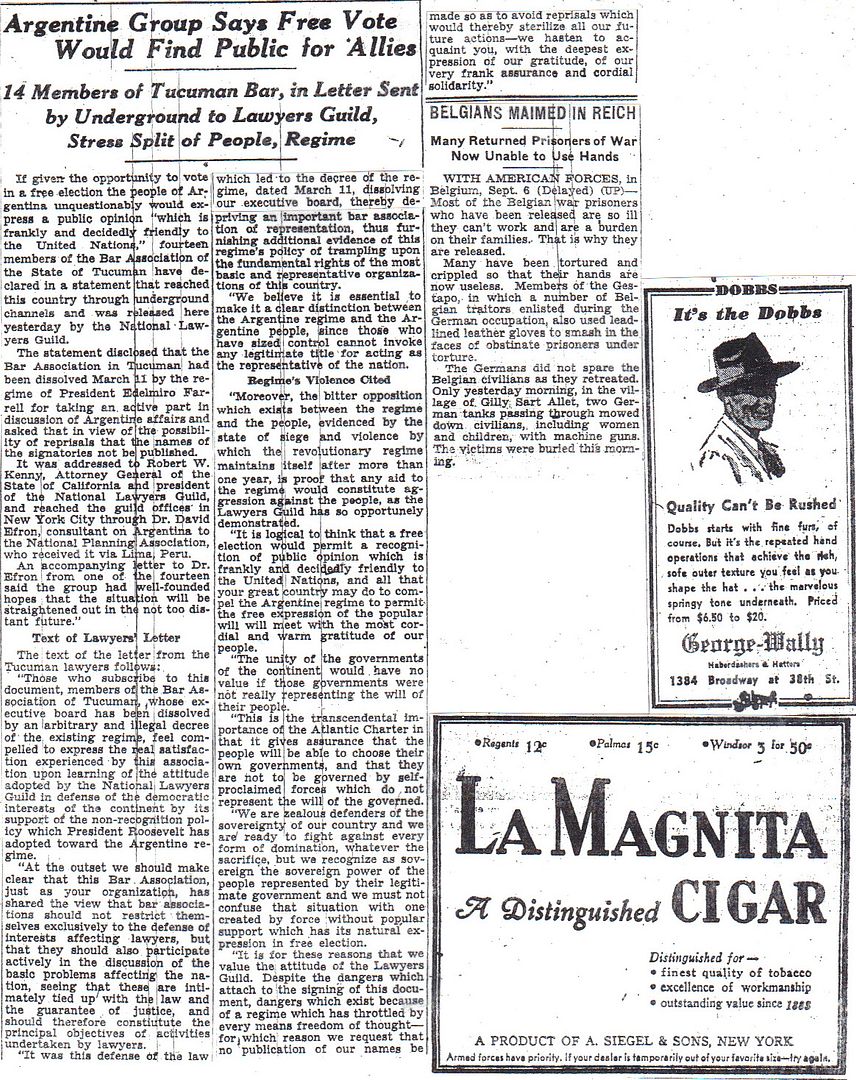
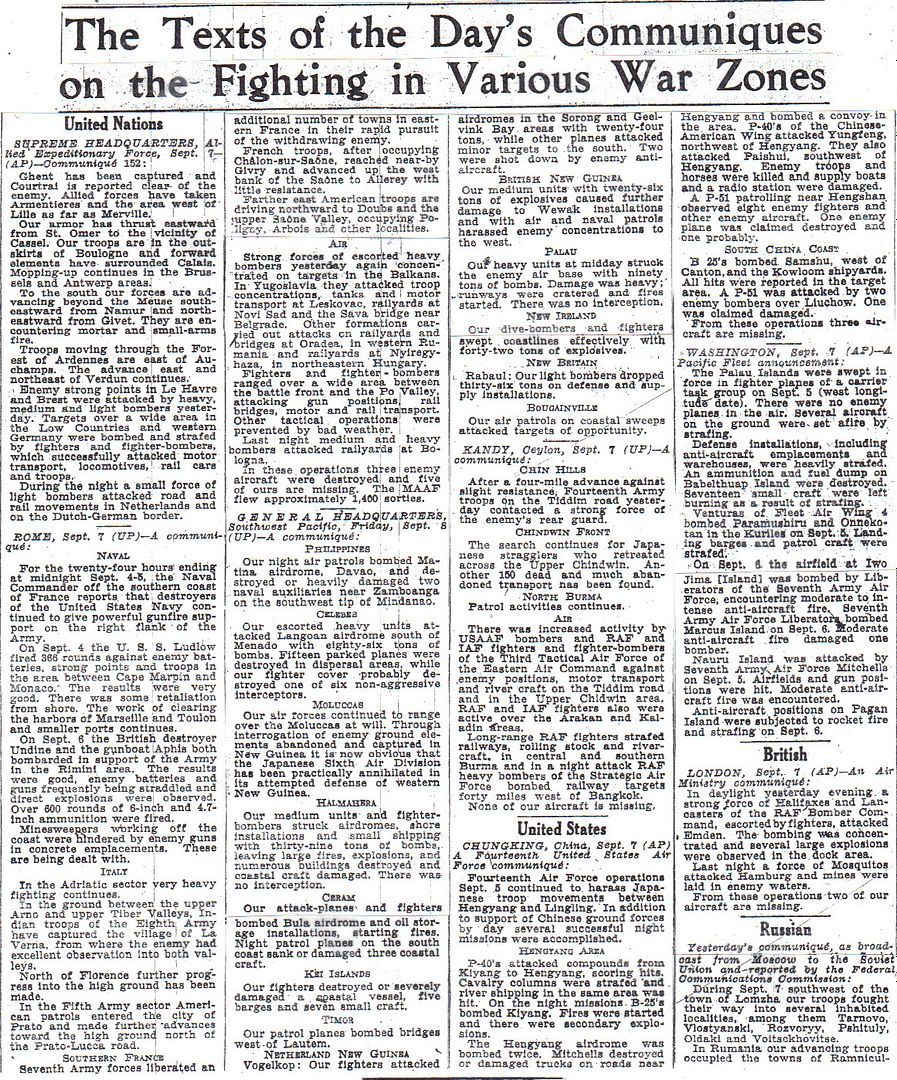
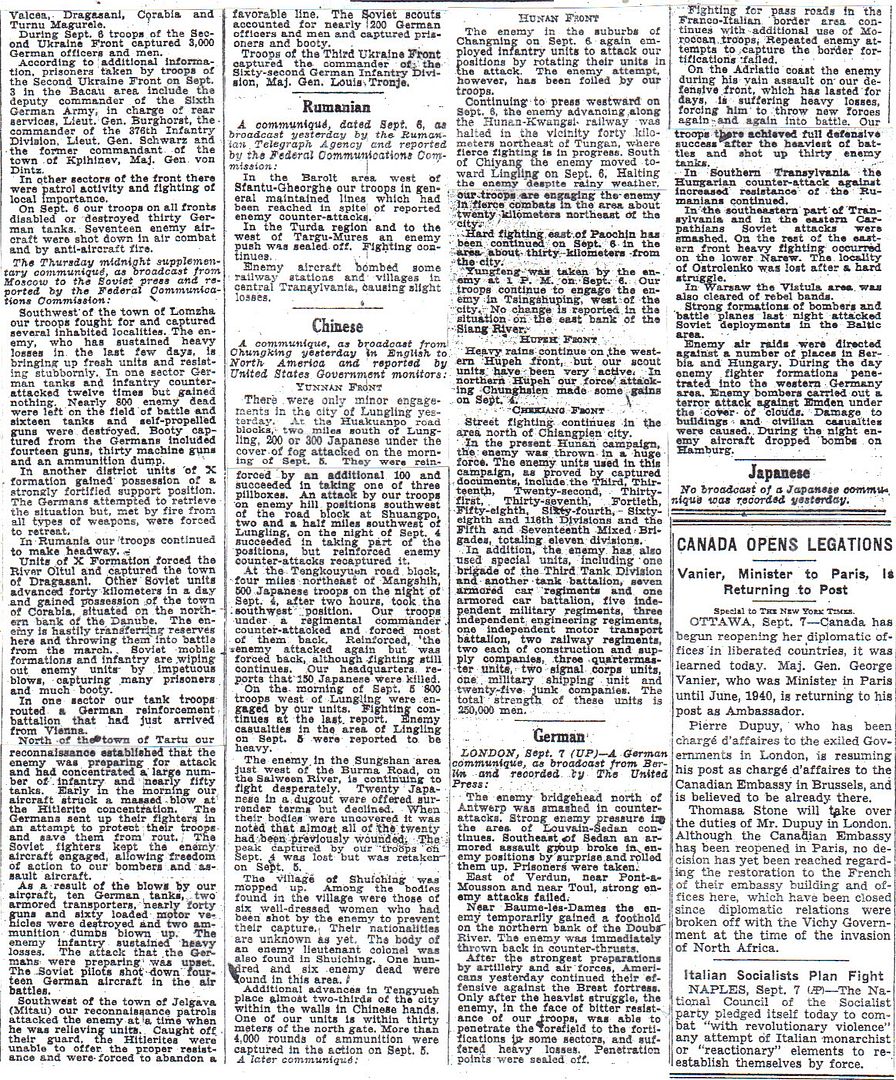
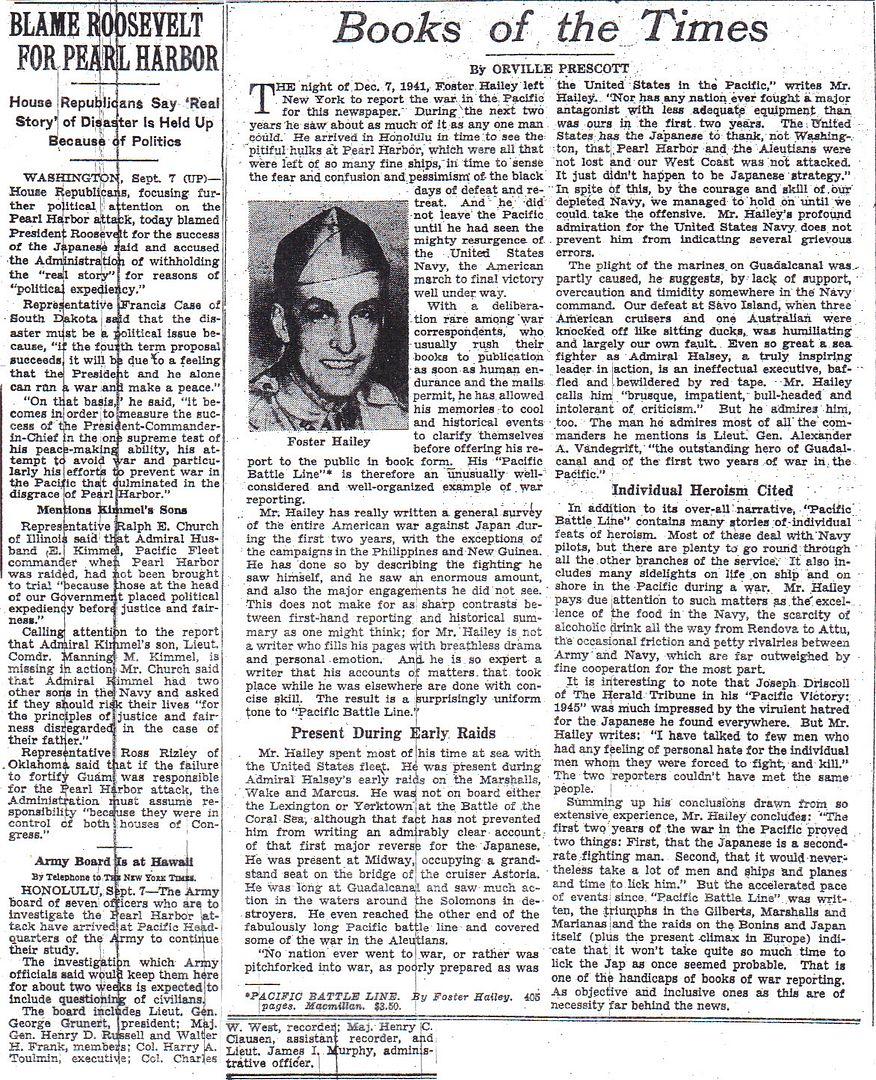
http://www.onwar.com/chrono/1944/sep44/08sep44.htm#
German V2 hits London
Friday, September 8, 1944 www.onwar.com
Over Britain... The first German V2 rocket lands in the Chiswick area of London.
On the Western Front... Troops of Canadian 1st Army (part of British 21st Army Group) capture Nieuport and Ostend. The US 7th Corps (part of US 12th Army Group) captures Liege.
In Southern France... The US 6th Corps (part of US 7th Army) captures Besancon.
In Italy... Forces of British 8th Army continue attacks against the German-held Gemmano and Coriano ridges, without success.
In Sofia... The Bulgarian government issues a declaration of war on Germany.
http://www.etherit.co.uk/month/thismonth/08.htm
September 8th, 1944 (FRIDAY)
UNITED KINGDOM: London: The first German A4 (Vergeltungwaffe 2 or V-2) rocket lands on Staveley Road, a quiet suburban road in Chiswick, West London, at 6.43pm, killing three people, seriously injuring 17, destroying six homes and leaving a massive crater. This is one of Hitler’s vaunted “vengeance weapons”.
It was fired, minutes before by Mobile Artillery Section 485 from a mobile launcher from the Koekoeslaan (Cuckoo’s Lane) a suburban road of The Hague, in the Netherlands, The explosion, and a second, just 16 seconds later (which lands in open countryside in Epping (north-east of London), but causes no casualties) are heard over much of London. Each sounded like a double thunder-clap followed by the rush of an express train.
It had been aimed at the Fire Station in Southwark Bridge Road but missed by eight miles. To avoid panic, and against the advice of scientists, no announcement of the new weapon was made. There are rumours that exploding gas mains were responsible. This morning, another rocket landed on the outskirts of Paris. By coincidence today Britons were told by Duncan Sandys, a junior minister, that the attack by V1 flying bombs was virtually over “except possibly for a few last shots”. The launching sites near Calais have been captured, but a small number of V1s are still being air-launched by Heinkel bombers over the North Sea. In the 80 days since they began, 2,300 V1s got through to London, killing 5,475 people, injuring 16,000 and destroying 25,000 houses.
“The London Gazette” describes the deeds for which Wing Commander Geoffrey Leonard Cheshire, D.S.O., D.F.C., Royal Air Force Volunteer Reserve has been awarded the VC. Article
US Eighth Air Force in England flies two missions.
- Mission 611: 1,070 bombers and 349 fighters,in 3 forces, are dispatched to hit industrial targets in the Mainz and Ludwigshafen, Germany area; attacks were visual at the primary targets; 10 bombers are lost.
(1) 348 B-17s attack the Opau oil refinery at Ludwigshafen; 5 B-17s are lost; escort is provided by 88 P-51s.
(2) 247 B-24s hit the Karlsruhe marshalling yard and 1 hits a secondary target at Ludwigshafen; 4 B-24s are lost; escort is provided by 82 P-51s.
(3) 386 B-17s are dispatched to hit an armored vehicle factory at Gustavsburg (167) and oil depot at Kassel (166); 23 others hit targets of opportunity; 1 B-17 is lost; escort is provided by 144 P-51s.
- Mission 615: 7 B-17s drop leaflets in the Low Countries, France and Germany during the night.
Other missions include:
- The VIII Fighter Command flies 2 missions.
(1) 160 P-38 Lightnings strafe and bomb rail transportation east of the Rhine River; they claim 7-0-1 aircraft on the ground.
(2) 194 P-47 Thunderbolts and P-51s strafe targets in the Heidelberg-Darmstadt-Wurzburg and Frankfurt/Main-Koblenz areas; 1 P-47 and 1 P-51 are lost.
- A C-47 Skytrain flies a CARPETBAGGER mission in France.
- 110 B-24s fly TRUCKIN’ mission to Bricy Airfield at Orleans, France.
BELGIUM: The US VII Corps captures Liege. The Canadian 1st Army captures Nieuport and Ostend.
In a stunning ten-day display of style and vigour, British Canadian and Polish forces have raced across northern France and into Belgium to liberate Brussels and capture the key port of Antwerp. Today they stand on the Albert Canal; behind them lies a trail of devastated enemy tanks, guns and trucks, and cages crowded with PoWs.
The task of leading the assault was given to Lt-Gen Brian Horrocks, who triumphed in Tunisia with his famous moonlight advance to take the Germans off guard. On this occasion his jumping-off point was a Seine bridgehead at Vernon; he stormed German defences and kept the enemy on the run with his moonlight manouvres. After a 40-mile drive to Amiens, he captured its German commander, General Eberbach, seized the town and secured the bridges over the Somme. Arras and Douai followed. The Guards Armoured Division entered Brussels on 3 September; Antwerp fell to the 11th Armoured Division the next day.
Hitler is desperately scrambling together new infantry divisions by drafting the elderly and disabled whic have been carrying out guard duties in rear areas. Sailors and airmen are being turned into foot soldiers. The Fuhrer has recalled to active service the man he sacked only two months ago for failing to repel the Allied landing in Normandy. Field Marshal von Rundstedt returned as C-in-C West with orders to halt the Allies until winter arrives, with fog, night and snow, to give the Third Reich a respite.
The Belgian government, exiled in London for the past four years, returns to Brussels.
NETHERLANDS: The U.S. 113th Cavalry Group (Mechanized) drives almost to Maastricht and patrols the Albert Canal in Belgium.
During the night of 8/9 September, two of three RAF Mosquitos bomb Havelte Airfield at Steenwijk.
FRANCE: The Canadians are besieging the Channel ports of Boulogne and Calais, where the Germans are clinging on in order to deny the Allies port facilities close to the front lines. The Canadian 2d Division captures Dunkirk while the 4th Armoured Division reaches the outskirts of Bruges and Polish armor reaches Thielt. The U.S. 2d, 8th and 29th Infantry Divisions of the U.S. Ninth Army begin an all-out assault on Brest at 1000 hours local. The German 106th Panzer Brigade counterattacks the troops of the U.S. 90th Infantry Division but becomes disorganized and is virtually wiped out losing 30 tanks, 60 half-tracks and almost 100 other vehicles. The enemy pocket in Briey surrenders to units of the U.S. XX Corps.
Besancon is liberated by the US VI Corps in the south of France.
In southern France, the 1st Airborne Task Force captures Menton and drives to the Italian border. The French 1st Armoured Division captures Autun. The Germans are beginning to withdraw from the Baume-les-Dames area to avoid being encircled.
The newly organized U.S. Ninth Army attacks Brest, a French naval base in Brittany.
Weather prevents US Ninth Air Force bomber missions; fighters fly cover for troops in the Brest area and for the US 2d, 5th, 8th, and 29th Infantry Divisions, and the XX Corps area, escort troop movements and fly defensive patrols; several hundred C-47s fly supply and evacuation missions.
In southern France: USAAF Twelfth Air Force A-20 Havocs fly supply missions to an airfield near Lyon; fighters strafe the Belfort area, hitting 10 trains with good results, and blast a horse-drawn vehicle convoy near Strasbourg.
During the day, RAF Bomber Command dispatches 333 aircraft, 304 Lancasters, 25 Mosquitos and four Stirlings, to bomb German positions at Le Havre but the weather is bad, with a low cloud base, and only 109 aircraft bombed, with indifferent results. Two Lancasters are lost. The four Stirlings of No. 149 Squadron on this raid are the last Bomber Command Stirlings to carry out a bombing operation.(22)
LUXEMBOURG: German troops withdraw from Luxembourg to positions behind the Seigfried Line.
GERMANY: Roland Friesler’s ‘People’s Court’ sentences Carl Friedrich Gördeler to death. (231)
During the night of 8/9 September, RAF Bomber Command dispatches Mosquitos to two targets: 44 of 45 Mosquitos dispatched bombed Nuremberg and four of six bombed Emden.
U-2507 commissioned.
U.S.S.R.: Baltic Fleet, Ladoga Lake and Chudskoe Lake Flotillas: MS “N-175” - lost at storm, close to Vidlitsa in Ladoga Lake (later supposedly raised and went into service) . (Sergey Anisimov)(69)
YUGOSLAVIA: Three hundred and fifty four USAAF Fifteenth Air Force B-17 Flying Fortresses and B-24 Liberators escorted by P-38 Lightnings bomb transportation targets: 103 bomb the Sava River railroad bridge in Belgrade; in Nis, 56 bombers attack the West marshalling yard and 48 hit the North marshalling yard; in Sarjaevo, 54 bomb the West marshalling yard and 15 hit the main marshalling yard; 41 bomb the Sava River railroad bridge at Brod;
ROMANIA: Mediterranean Allied Tactical Air Force C-47 Skytrains fly evacuation missions to Bucharest, Romania, and return to Italy carrying Allied POWs.
BULGARIA: Soviet troops cross the border into Bulgaria, ostensibly because of Bulgaria’s refusal to declare war on Germany.
GREECE: German forces begin to withdraw.
Soviet troops are now 26 miles inside the country.
ITALY: Units of the U.S. Fifth Army cross the Serchio River and enter Vecchiano without opposition. The flooded Arno River prevents the South African 6th Armoured Division from crossing reinforcements.
The British Eighth Army continues its attacks on Gemmano and Coriano ridges in Italy. Two days of rain have seriously interrupted operations. These attacks are heavily fought and the positions remain in German possession.
USAAF Fifteenth Air Force P-51s escort RAF Beaufighters to Trieste, Italy
During the night of 8/9 September, 71 RAF Liberators of No. 205 (Heavy Bomber) Group bomb the canal at Ravenna.
CHINA: Chungking: Operating for the first time in daylight, 90 Chengtu-based B-29 Superfortresses of the US XX Bomber Command bomb the Showa Steel Works at Anshan, in Japanese-controlled Manchukuo. 3 others bomb other targets in Anshan, 5 hit Sinsiang railroad yards, and 3 others hit various targets of opportunity; Major General Curtis Emerson LeMay, Commanding General XX Bomber Command, accompanies the mission. Tokyo Radio claims three B-29s are shot down, but in fact the USAAF suffered no losses. During the night of 8/9 September Japanese bombers attack HQ, storage areas, and parked aircraft at Hsinching (near Chengtu) damaging a B-29, a C-46 Commando, and wounding 2 soldiers.
U.S. Major General Patrick J. Hurley assumes his post as U.S. Ambassador to China.
Lieutenant General Joseph Stillwell, Commander in Chief U.S. China-Burma-India (CBI) Theater of Operations, agrees to a War Department proposal that the CBI Theater be split and that he be relieved of responsibility for lend-lease matters in order to concentrate on support of Pacific operations from China. Generalissimo Chiang Kai-shek proposes to Stillwell that Chinese troops from Myitkyina, Burma, be employed in the battle for Lung-ling, Burma.
Japanese ground forces overrun the USAAF Fourteenth Air Force airbase at Lingling. A second force is advancing on airbases from the south.
BURMA: On the Salween front, the Japanese, having assembled strong reinforcements, begin attacks on Chinese positions north of Lung-ling.
23 US Tenth Air Force B-24s haul fuel to Kunming, China; large-scale troop carrier operations to many CBI terminals continue.
Nine USAAF Tenth Air Force B-25 Mitchells bomb Katha.
FRENCH INDOCHINA: 18 US Fourteenth Air Force B-24s attack 5 railroad bridges at Giap Nat, Dui Giang, Hue, Trach, Duc Tho, and Quang Tri, knocking out the Quang Tri bridge. 3 B-24s claim a destroyer sunk south of Hong Kong. In China, 100+ P-40s and P-51 Mustangs on armed reconnaissance hit a large variety of targets of opportunity including troops, river shipping, bridges, airstrips, supplies, trucks, and railroad targets over the vast southeast China areas at Lingling, Kiyang, Tunganhsien, Hengyang, Lingkuantien, and Leiyang.
EAST INDIES: In the Netherlands East Indies, USAAF Fifth Air Force B-24 Liberators bomb Langoan Airfield on the northeast tip of Celebes Island. On Halmahera Island, B-25 Mitchells hit Galela and Tobelo while B-24s bomb Lolobata and P-47 Thunderbolts attack Kaoe Airfield and antiaircraft positions, Djailolo Airfield and barges at Point Lelo. On Ceram Island, P-38 Lightnings hit Boela Aerodrome while B-25s hit small shipping.
NEW GUINEA: In Dutch new Guinea, USAAF Fifth Air Force B-24s bomb airfields at Langgoer, Faan, Letfoean, and Toeal; fighter-bombers and A-20s hit airstrips and targets of opportunity at Efman, Samate, Babo, Urarom, Manokwari, Moemi, and Ranski; and P-39Airacobras strafe the Wewak coastal area.
BONIN AND VOLCANO ISLANDS: USAAF Seventh Air Force B-24 Liberators bomb Iwo Jima in the Volcano Island and two cargo vessels are damaged off Chichi Jima in the Bonin Islands.
CAROLINE ISLANDS: USN carrier based aircraft of Task Groups 38.1 and 38.4, plus surface ships, bombard targets in the Palau Islands.
USAAF Seventh Air Force B-24 Liberators based on Saipan bomb Pagan Island while B-25 Mitchells from the Gilbert Islands hit Ponape Island .
MARIANA ISLANDS: USAAF Seventh Air Force B-24 Liberators bomb Pagan Island.
MARSHALL ISLANDS: USAAF Seventh Air Force B-24 Liberators bomb Wotje Atoll.
PACIFIC OCEAN: USN submarines sink five Japanese ships: USS Bashaw (SS-241) sinks a transport west of Mindanao, Philippine Islands and USS Spadefish (SS-411) sinks a transport, an army cargo ship and two merchant cargo ships east of Formosa.
CANADA: Frigate HMCS Royalmount arrived Halifax from builder Montreal, Province of Quebec.
U.S.A.: The Joint Chiefs of Staff (JCS) issue a directive to General Douglas MacArthur, Supreme Commander, South West Pacific Area. and Admiral Chester Nimitz, Commander Pacific Ocean Areas, for the invasion of the Philippine Islands.
Ed Wynn resumes his radio career after 7 years off the air. Wynn’s new show, “Happy Island,” debuts on the NBC Blue Network on Fridays at 1900 hours Eastern. Wynn plays King Bubbles, ruler of the mythical Happy Island, where good humor and joy are the order of the day. The show remains on the air until February 1945. The show is sponsored by Borden’s Milk and during the commercials, Hope Emerson plays Elsie the cow.
Submarine USS Kraken commissioned.
Destroyer minelayer USS Shannon commissioned.
Destroyer USS Wallace L Lind commissioned.
The USN commission the light cruiser USS Springfield (CL-66) at Boston, Massachusetts. This is the 37th light cruiser in commission.
Coast Guard-manned Army vessel FS-266 was commissioned at New York. Her only commanding officer was LTJG J. D. Legon, USCGR. On October 2, 1944 she departed New York after a trip to Daviaville, RI, for the Southwest Pacific, where she operated during the war. On 25 November 1945, Coast Guard crew was relieved by a civilian officer and crew.
ATLANTIC OCEAN: U-482 sank MS Pinto and SS Empire Heritage in Convoy HXF-305.
“Weather prevents US Ninth Air Force bomber missions”
I have been meaning to ask this question all summer. Is the weather always this bad in Europe or did they get the wrong summer weather wise? Seems like there is a storm every other day hampering flying.
The weather was particularly bad during the Summer of 1944. The June storm that wrecked the American Mulberry harbor was of a severity normally seen in December, not June. Most of June and early July were generally rainy and overcast in Normandy. Operation Cobra was delayed a day because of weather conditions preventing the bombers from identifying their target.
However, the latter half of July and August were more typical weather-wise, the allied tactical air forces had a field day at Falaise and at the Seine Crossings.
We’re getting into September now, and the weather over northwest Europe will progressively deteriorate. I’m a Formula 1 fan, and just two weeks ago, they raced at Spa in Belgium. The quote for that race is “It always rains at Spa.” Every Belgian Grand Prix I can recall has had rain for qualifying or the race. The weather will deteriorate to the point that in November, allied air power will virtually cease to be a factor on the battlefield. In December, in the Ardennes, it will be completely absent for about two weeks.
This is not the first time unusually wet summer weather hampered military operations in Europe. I just watched a show about the 1917 Battle of Passchendale. The offensive was launched in dry weather on July 31. A few days later, the heaviest August rains seen in 30 years began to fall, and all the survivors remembered about Passchendale was mud and death.
Summer in Europe can have bad weather.
I realize that high-altitude bombing carries greater protection for the bombers, but if your infantry is being mauled, as at Bastogne in December, don't you order up air support regardless? And fighters are often down on the deck routinely.
I must be missing something here...
Not being a flyer, I can only speculate. One would be that even the close support guys have to fly at altitude to orient themselves and locate the target. Normally you see the Jabos (as the Germans called them) circling their target from about 5,000 to 10,000 feet and then making their runs. That also allows them to spot flak, and more importantly, to spot any dangerous terrain features and avoid them in making a run.
If the ceiling is too low, they can’t spot the target, and more importantly, can’t fly safely.
In the absence of any official declaration or news dispatch explaining this, we're left to speculate about a matter that recurred frequently and apparently had important ramifications.
I would also like to point out that many of the Allied Tactical Air strips in France were grass fields. Rain would obviously make take offs and landings rather hazardous to say the least.
Also as henkster mentioned cloud base has a lot to do with tactical aircraft operations. Any cloud base lower than 2 to 3,000 feet above the ground would make operations difficult. Also a lot of navigation at that time was visual and flying at 250 to 300 knots would have made target id rather difficult.
We had enough problems with friendly fire on clear days not to mention what would happen on days when the cloud base was close to the deck.
Regards
alfa6 ;>}
Thanks.
There is reason why Northern France is so green and verdant. It’s what T.E. Lawrence said of England, a “fat land.” Rural France is beautiful, but I never had to march across it or live in a foxhole dug in it or crawl across it under fire.
Ceiling is one aspect of flying, visibility is another. If the ceiling is low, visibility is also going to be low
Certainly in an emergency, highly skilled pilots could operate with limited effectiveness under such conditions but typical pilots would suffer needlessly high casualties and be at high risk of inflicting/receiving blue on blue casualties. Remember, if allied aircraft attacked allied ground forces, allied AA crews were under shoot to kill orders and AA crews would be credited with such "blue" kills.
At 250mph, an airplane is moving 366 feet per second. If visibility is 2,000 feet, the pilot has just 5.5 seconds from the moment he spots a potential target dead ahead until his plane is directly above it. His time to spot a target to either side of his plane is even less. All this time he needs to maintain an awareness of where he is at by visually identifying landmarks, something not easily done under adverse weather conditions during combat operations.
Let's not forget that he is part of a flight of aircraft so he must continually maintain awareness as to where his other aircraft are.
Assuming they happen upon a nice target, ground attack aircraft like to attack in such a way as to avoid concentrated ground fire. This means the planes must disperse and try to attack more or less simultaneously from different compass points. Difficult to do at 250 mph under low ceiling and visibility.
Perhaps the pilots could slow down to say 125 mph. Doing so will double the time they have to search for targets, maintain orientation and flight position. However, if they are flying at 1,000 feet at 125 mph, they will be extremely vulnerable to small arms fire. The overcast conditions will enable 8mm tracers to burn brightly and quickly fade upon entering the clouds just above the aircraft. This rapid fading of tracers in the clouds makes aiming easier because bullets that traveled beyond the aircraft quickly disappear from view. An altitude of 1,000 feet is just 330 yards which is well within lethal range of 8mm bullets, thousands and thousands of which will be coming up at the planes. Actually, going so slow and low over enemy territory could be expected to draw continuous small arms fire. Yes, the planes had some armor protection but not that much.
So, the best course of action under such weather conditions would be to just leave the planes parked, give the pilots a rest and aircrews time to do needed maintanance.
And yet...isn't it worth it in some extreme emergencies to put a few pilots at unusual risk to save thousands? The obvious example was Bastogne. There was the need to drop supplies fairly accurately. (I think I recall reading that some such effort was indeed made, though ineffectually.)
Disclaimer: Opinions posted on Free Republic are those of the individual posters and do not necessarily represent the opinion of Free Republic or its management. All materials posted herein are protected by copyright law and the exemption for fair use of copyrighted works.